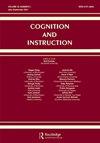“What Do You Think She’s Going to Do Next?” Irresolution and Ambiguity as Resources for Collective Engagement
IF 2.6
1区 心理学
Q2 PSYCHOLOGY, EDUCATIONAL
引用次数: 1
Abstract
Abstract Understanding how learning environments productively mobilize children’s ideas as resources for participation in joint activity is an ongoing focus of research on classroom instruction. We investigated whole-class mathematics conversations in which multiple students participated in ways previous research suggests are consequential for learning. We found that in such conversations, students rarely presented the entirety of their solutions before other students engaged. Rather, incomplete explanations and written representations that emerged over time created entry points for other students to contribute in mathematically substantive ways. These aspects of student participation operated in combination with teachers’ in-the-moment responses to create opportunities for, and publicly recognize, different kinds of contributions as resources for collective work. Our findings suggest that, rather than challenges to communication that must be overcome, students’ vague, unfinished, and ambiguous ideas present productive contributions that can be leveraged to support collective mathematical work.“你觉得她下一步会做什么?”作为集体参与资源的不确定性和模糊性
摘要了解学习环境如何有效地调动儿童的思想,将其作为参与联合活动的资源,是课堂教学研究的一个持续焦点。我们调查了全班数学对话,在这些对话中,多名学生以先前研究表明对学习有影响的方式参与。我们发现,在这样的对话中,学生很少在其他学生参与之前提出他们的全部解决方案。相反,随着时间的推移,不完整的解释和书面陈述为其他学生以数学实质性的方式做出贡献创造了切入点。学生参与的这些方面与教师的即时反应相结合,为不同类型的贡献创造机会,并公开承认这些贡献是集体工作的资源。我们的研究结果表明,学生们模糊、未完成和模棱两可的想法并不是必须克服的沟通挑战,而是可以用来支持集体数学工作的富有成效的贡献。
本文章由计算机程序翻译,如有差异,请以英文原文为准。
求助全文
约1分钟内获得全文
求助全文
来源期刊

Cognition and Instruction
Multiple-
CiteScore
7.90
自引率
12.10%
发文量
22
期刊介绍:
Among education journals, Cognition and Instruction"s distinctive niche is rigorous study of foundational issues concerning the mental, socio-cultural, and mediational processes and conditions of learning and intellectual competence. For these purposes, both “cognition” and “instruction” must be interpreted broadly. The journal preferentially attends to the “how” of learning and intellectual practices. A balance of well-reasoned theory and careful and reflective empirical technique is typical.
 求助内容:
求助内容: 应助结果提醒方式:
应助结果提醒方式:


